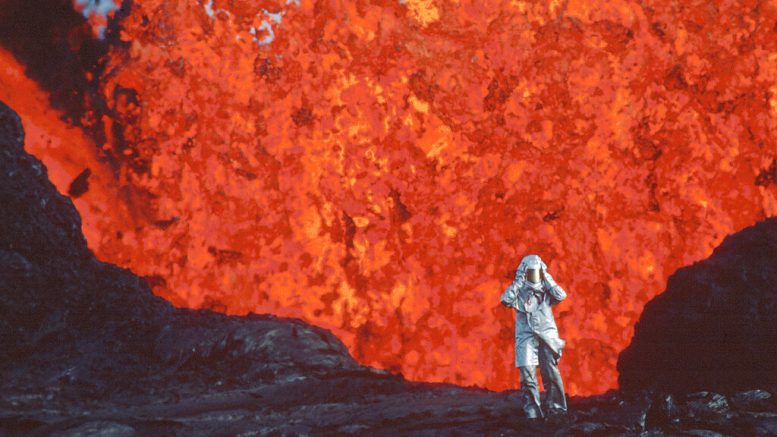The Associated Press
Rarely have the conditions for love been less hospitable than in Sara Dosa’s documentary “Fire of Love.” Yet here, amid shifting tectonics and quaking craters, French volcanologists Katia and Maurice Krafft forge a strangely rock-steady romance.
“Fire of Love,” excavates their unique story, and the jaw-dropping footage the Kraffts left behind, in a film exploding with awe for the mysterious alchemies of love and obsession.
The Kraffts were prominent scientists in the ‘70s and ‘80s whose passion and occasional red knit hats made them a bit like the Cousteaus of the volcano world. Like that underwater explorer, the Kraffts also picked up filmmaking to chronicle their investigations — which often drew them, like moths to the flame, perilously close to not-at-all-dormant volcanoes. They died in 1991 in a cascading gray cloud on Japan’s Mount Unzen, leaving behind hundreds of hours of footage, and as narrator Miranda July says early in the film, a million questions.
Maurice, a gregarious geologist, and Katia, a more reserved geochemist, were brought together by their mutual infatuation for volcanoes. After marrying, they decided not to have children and instead dedicated themselves to being, as Maurice terms it, “volcano runners.” They travel from active volcano to active volcano, living according to the Earth’s rhythms. With a wry smile, they confess many of their colleagues view them as weirdos.
“If I could eat rocks, I’d stay on the volcano and never come down,” Maurice says proudly in one TV interview.
Dosa uses July’s narration to frame the Kraffts’ story with a playful sense of wonder and whimsy — a sometimes overly intrusive, too neatly packaged device in a film where what’s on screen is so overwhelmingly powerful that it might not need the extra layer.
Again and again, we see the couple traversing charred alien landscapes with geysers of spewing lava. Their protective outfits are a little nutty, too, like props from an old science-fiction film or something left over from the henchmen of a Bond villain. But with rivers of red all around, they are almost at play — wild silhouettes dancing on the precipice. When set to Brian Eno’s beguiling “The Big Ship,” the imagery isn’t hellish but heavenly.
On one volcano, Maurice fries an egg on the hot ground. On another, he paddles an inflatable raft over a steaming lake of acid. Katia objects to that gambit but they are resolutely inseparable. Still, if “Fire of Love” is principally a love story, the chemistry we see between them isn’t the sort that makes you swoon. It’s easy to wonder if what binds them together isn’t so much love as mutual obsession. They both burn with a red-hot desire less for each other than to be as close to the volcano as possible. Are they chasing life, or death? Maurice calls it “a kamikaze existence.”
But what’s unknowable is also at the heart of “Fire of Love,” a movie about two people not afraid but intoxicated by forces far larger than they are. Katia and Maurice are, she says, “like flies in a saucepan that’s boiling over.” And it’s their contagious sense of awe for nature that keeps the flames of “Fire of Love” smoldering.
“Fire of Love,” a Neon release, is rated PG by the Motion Picture Association of America for thematic material including some unsettling images, and brief smoking. Running time: 93 minutes. Three stars out of four.
For more entertainment news, visit TheDerrick.com.










































